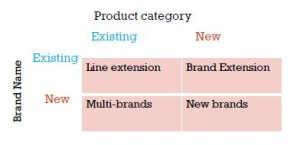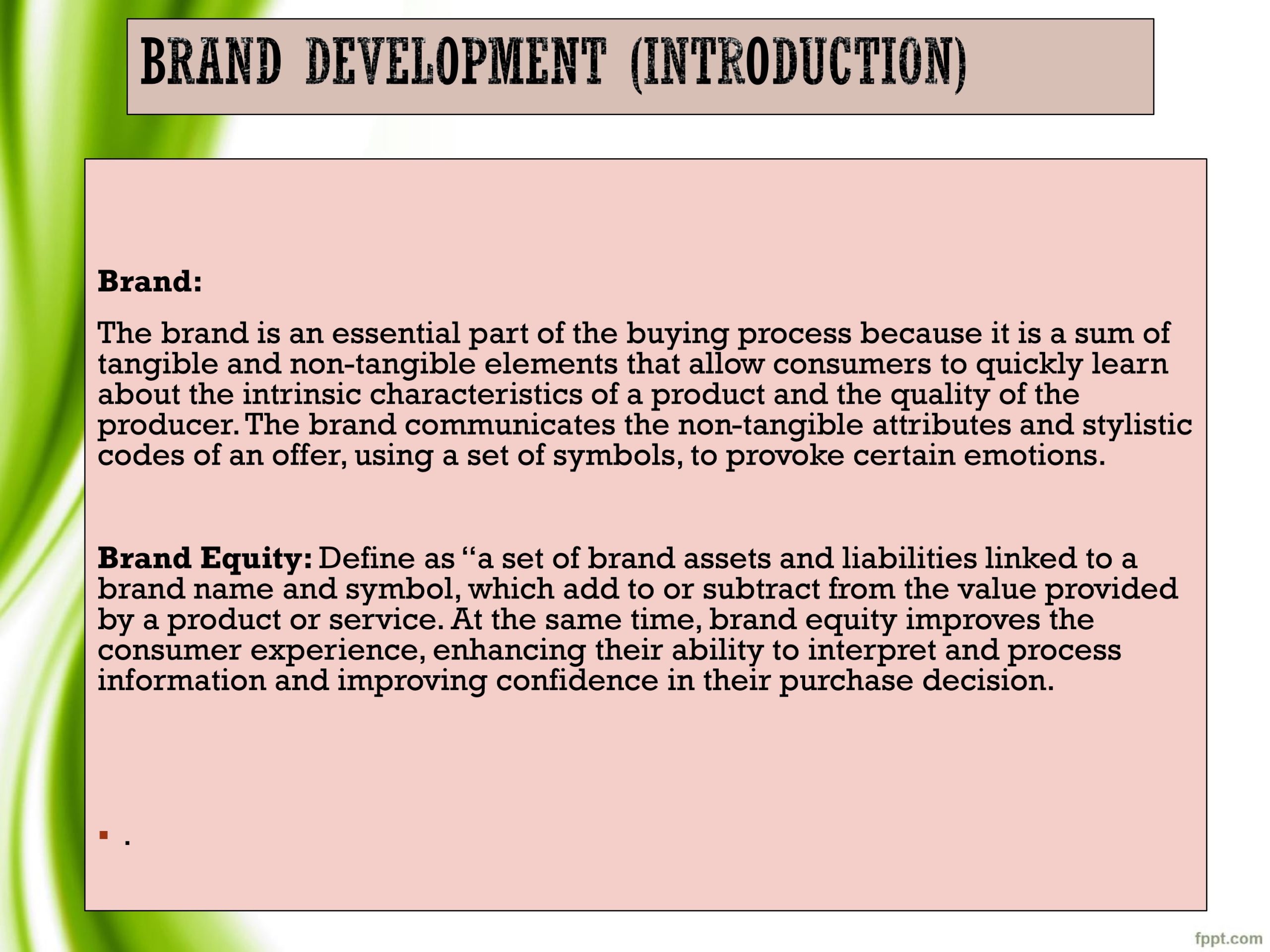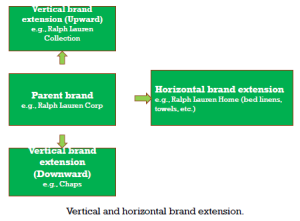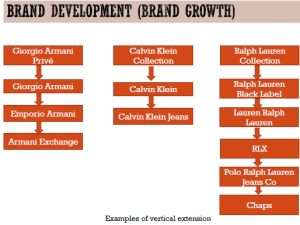
Fashion Brand Development: All You Need to Know
Fashion Brand Development
In this article we will learn various aspects of fashion brand development which includes the four choices to develop a brand, important definitions, classification of brands depending on target segments or the positioning strategy, brand strategy, brand development principles, branding process, etc.
Introduction of Fashion Brand Development
A company has four choices when it comes to developing brand. It can introduce line extension, brand extension, multibrands or new brands.

4 choices of developing a brand.
- Line Extension: Line extension occur when company extends existing brand names to new form, colors, sizes, ingredient or flavors of an existing category.
- Ex: Bata one of the oldest footwear brand in most countries, has expanded its footwear line to includes regular shoes, premium shoes, sports shoes, sandals.
- Brand extension: A brand extension extends a current brand name to new or modified products in a new category.
- Ex: Nestle has leverages the strength of its Maggi brand to launch several new lines; Maggi Noodles, Maggi Soup, Maggi Tomato Katchup.
- Multi-Brands: Companies often introduce additional brands in the same category. Unilever and Procter & Gamble markets many different brands in each of their product category.
- Ex: Same category such as shampoo, Bangladeshi Unilever introduce multi brands such as Sunsilk shampoo, Dove shampoo, Tresmme Shampoo.
- New Brands: A company might believe that the power of its existing brand name is waning and a new brand name is needed. Or it may create a new brand name when it enters a new product category for which none of the company’s current brand names are appropriate.
- Ex: Tata motors created the separate ace brand, targeted toward small transporters or those who have just started their transport business.

- Branding is personalizing a product to ensure a balance between different economic values. The aim of branding is to make a link between the character of an object and its branded image or form. Branding is a disciplined process used to build awareness, attract new customers and extend customer loyalty.
- Brand identity is tangible and appeals to the senses. How a business presents itself to — and wants to be perceived by — its consumers.You can see it, touch it, hold it, hear it, watch it move. Brand identity makes big ideas and meaning accessible.
- Brand Image- The way a company chooses its name; designs its logo; uses colors, shapes and other visual elements in its products and promotions; crafts the language in its advertisements; and trains employees to interact with customers – all with the goal of cultivating a certain image in consumers’ minds.Brand image is the actual result of these efforts, successful or unsuccessful.
- Brand Governance: Brand management requires strategy, planning and orchestration. It begins with thoughtful leadership, a shared understanding of core purpose and brand fundamentals and an imperative to grow brand equity. It’s finding new way to delight customers, to engage employees, and to demonstrate your competitive advantage.
- Brand Architecture: The term “brand architecture” describes the organization and structure of the brand portfolio, specifying brand roles and the relationship between brands and between different product-market contexts. Well-developed and managed brand architecture generates clarity, synergy, and brand leverage—three goals of brand architecture.
Brand Name
A brand is a name. Something that you can speak. Sometimes, it’s a symbol. Sometimes, it’s a design. Brands are important to the consumer because it enables the marketer to create perceptions and images that the brand presents. If we can get the consumer to perceive that one brand– or our brand– is better than our, our competitor’s brand, that perception becomes their truth. That truth becomes a purchase. The part of the brand that can be spoken is called the ‘brand name.’
What’s a Brand Mark?
The key to a brand is to have it legally trademarked through the Trademark Office so that you can be sure that no competitor can have use of the name or the symbol. If you look at the Nike, you automatically know that it is Nike. That is called the ‘brand mark.’
The classification of fashion brands
Depending on target segments or the positioning strategy, brands can be classified into four categories: 1.Griffe, 2.Luxury brands, 3.Premium brands, and 4.Mass-market brands. The higher the price range, the narrower the target audience as fewer people can afford it.
- 1.Griffe, or designer brand: Is at the top of the pyramid. The term griffe is derived from handwriting and refers to the pure creation of an item by hand, created in atelier. Thus, it is unique, irreproducible, and eternal. Yves Saint Laurent is an example of griffe.
- 2.Luxury brands: Luxury brand, which originates from either designer brands (e.g., Dior and Chanel) or craftsmanship (e.g., Gucci and Louis Vuitton). Luxury brand has six features: excellent quality, high price, scarcity and uniqueness, aesthetics and polysensuality, ancestral heritage and personal history, and superfluousness. The essential elements of luxury products are craft, uniqueness, exclusivity, and artistic talent—though some crafts have been replaced by machines.
- Luxury brands offer excellent quality, scarcity and uniqueness, and excellent aesthetics and poly-sensuality— all of which claim these products a high price. Luxury brands are also characterized by its ancestral heritage, personal and cultural history, and geographical roots. The last characteristic of luxury brand is its superfluousness. Luxury brands are often described as those “brands that no one really needs, but everyone desires. Originally, luxury items were made for royalty, aristocracy, and the upper class until the nineteenth century. As such, luxury brands have a strong connotation of success, allowing consumers to attain a privileged social standing through these items. In the luxury fashion area, the ‘brand name’ is everything, because it is the name and the logo that attracts the consumers and creates an often long lasting relationship between them and their selected ‘luxury brand’. It is the first contact between the brand and the consumer and should reflect everything the brand stands for.
- Keller (2009) defines ten characteristics of ‘traditional-luxury brands’, offering strategic brand management applications. (1) A premium image for luxury brands is crucial and therefore the control of this image as well. (2) Luxury branding involves the creation of many intangible brand associations and an aspirational image. (3) The marketing program must ensure that the quality of the product and service is aligned to guarantee an extraordinary experience for the customer. (4) Brand elements, such as the brand names, logos, symbols, packaging, signage etc., can be important drivers for ‘brand equity’. (5) Drives for ‘brand equity’ in luxury could be associations from linked personalities, events, countries or other entities.
- (6) Distribution must be strictly controlled through selective distribution channels. (7) ‘Luxury brands’ should follow a premium pricing strategy. (8) ‘Brand architecture’, which is the amount and nature of common or distinctive brand elements that are applied to products sold by the company, must be managed carefully. (9) Competition for luxury brands must be defined broadly, as those brands often compete with other luxury brands from different categories. (10) ‘Luxury brands’ must protect their trademarks legally and strictly to fight counterfeit goods.
- 3. The third brand category is premium brand: Also called new luxury or new luxe, premium brands have elements from both luxury and mass-market brands. They are at the top of the mass-market spectrum concerning price, yet at the same time they are more accessible than luxury brands. Premium brands have refined their products and branding strategies, proposing alternatives to luxury for a better value. Truong et al. (2009) give some suggestions how ‘new-luxury brands’ could be managed and suggest that brand managers should invest resources to create a prestigious environment around the brand, so it appeals to the consumers as something they need to aspire for. They can do this by establishing visually attractive and prestigious stores or divisions in department stores and through advertisements in glamorous magazines, holding fashion shows and signing up well-known designers. Limited price premiums (temporary discounts) shall ensure that the middle class consumer has only occasional access to the brand.
- Premium brands have three sub-categories:
- Super-premiums: Priced at or near the top of their category such as Emporio Armani, these brands target consumers who belong to classes immediately below the traditional pure luxury customers.
- Old luxury brand extensions: lower-price versions of products created by companies such as Valentino Prêt-à-Porter whose brands have traditionally been affordable only by the rich.
- Masstige: Priced well below super-premium or old luxury brand extensions such as Victoria Secret. It is oftentimes premium in terms of price and quality among mass products.
- The critical success factor of the premium brand strategies lies in the prestige, differentiation, and a reasonable premium price. Companies need to invest resources to create a prestigious environment around the brand in order to promote public aspiration for the brand. Such an environment is created through availability in prestigious stores or sections in department stores, advertisement in glamorous magazines and fashion shows, and involvement of well-known designers. At the same time, adequate price premiums ensure limited access to the brand for the mass market. Ideally, middle-class consumers should have only occasional access to the brand.
- 4. The last brand category is mass-market brands/non-luxury brands/Classic: Products in these brands are generally mass produced, widely distributed, and have a low selling price. The quality level of these products are acceptable. The mass-market brand caters for a wide range of customers, producing ready-to wear garments using trends set by famous names in fashion. In order to save money and time, they use cheaper fabrics and simpler techniques that can easily be produced by machines. Examples of mass-market brands are those found in mass retailers such as Tesco, Wal-Mart, Marks & Spencer, or specialty stores such as Old Navy.
- Fashion brands can also be categorized by their distribution strategy as national or private label brands. Also called retail brands, private labels, and store brands, these are brands of retailers—not producers and designers—who commission the production, market the products under their store name, and own the right to sell the brand exclusively in their retail outlets.
- Examples include Club Room, INC, and Alfani, the private brands of American Macy’s department store. Chain retailers such as Gap, Ann Taylor, H&M, Top Shop, Next mainly sell their private brands only in their stores, and oftentimes, their brand and store names are the same. The target of private brands ranges from mass market to premium brand, and retailers are increasingly developing more private labels for differentiation. In contrast, manufacturer brands are carried out by producers who have direct control over them. These brands are distributed in the national store chains, the reason they are also called national brands. Examples include Mexx, Guess, and Ralph Lauren.
WHAT’S A BRAND STRATEGY?
Brand strategy is a long-term plan for the development of a successful brand in order to achieve specific goals. A well-defined and executed brand strategy affects all aspects of a business and is directly connected to consumer needs, emotions, and competitive environments.
Phase 1: Research & Audit
- An in-depth research and audit process lays the groundwork for all future branding efforts. The purpose is to identify where your brand is today, so you have a clearer view of where it needs to be tomorrow.
- To gain a historical perspective and a better understanding of your brand equity, you should begin by analyzing all of your current marketing materials. These can include:
- Mission statement
- Vision
- Value proposition
- Organization chart
- Business plan
- Marketing plan
- Annual reports
- Existing market research
During this phase, it’s also important to analyze your competitors’ brands as well. Part of this discovery phase is about uncovering your strengths, weaknesses, and (most importantly) opportunities in the market.
Phase 2: Define Your Brand
- Brand values – typically 4-5 words or phrases that describe the things your brand stands for.
- Mission –a statement that dictates what your ultimate aim is as a business.
- Vision – A statement that communicates the long-term impact of your work. While the mission may evolve over time, the company’s vision is unchanging.
- Brand story – a written narrative that describes where you’ve come from and where you are going. It’s usually conversational, and is rooted in purpose to inspire an emotional connection.
Phase 3: Position Your Brand
In developing a brand, the most important decision is its positioning. It’s time to make your brand tangible. This task can be accomplished by asking four questions: what is the benefit and purpose of the brand? who is the target potential customer? what are the differentiators that support and can create such a benefit? and who is the competition? This positioning process shapes the product mix and identity of the brand. The following outlines the basic elements you’ll need to think about during this phase.
Brand name
A good brand name is easy to spell, easy to pronounce, intriguing, and reflective of your brand’s core values.
Logo design
It’s an immensely important element of one. A well designed logo will reflect your brand’s personality.

The logo of Fashionnovation created by Kazi Purba
Typography
At this step, ask yourself: Do these fonts reflect my brand’s image? Are they aesthetically pleasing? Can my audience read them?
Color palette
Colors can trigger both direct associations (sky blue, green grass) and indirect associations (passion, creativity, authority), adding an important layer of depth to your brand’s identity. Choose wisely, and choose intentionally.
Phase 4: Brand Awareness
All of your research, positioning statements, visual assets, and messaging should be combined into one comprehensive brand book (commonly referred to as a Style Guide).
When done properly this book will ensure consistency, both internally and externally.
Phase 5: Brand Measurement
Building your brand takes significant time, research and resources. Once your brand is established, you can’t just let go and forget it. A brand needs to be monitored and measured on a consistent basis.
Measuring internal and external performance will include speaking with your staff, customers, and even monitoring conversation online via social listening tools. Ask your team if they understand the target audience, customer insights, and brand drivers. Ask your customers if they recognize your logo, know what your brand stands for and hold a sense of loyalty to your brand.
- Once a brand and its positioning is established, a firm needs to communicate the brand to its customers. As a firm grows, a brand alone may not be enough to address the customers’ diverse needs and increase market share. Two important decisions in brand growth should be focused: brand extension and brand portfolio strategy.
Brand extension: The use of an established brand name to introduce a new product or class is one of the most highly utilized growth strategies in the fashion industry. Given that new product development requires high cost and its success is not high, brand extension is an economical option for fashion companies to increase their market share by leveraging the value of their existing brands.
- The brand that gives birth to a brand extension is termed the “parent brand.” There are two types of brand extensions: horizontal (also called category extension) and vertical (or line extension). Brands extend horizontally to a new product class or category not currently offered by the brand but at the same price and quality level as the existing brand. Examples of horizontal brand extension include Prada’s introduction of fragrances and eyewear within the same price range and quality level as their parent brand. Brand can also extend vertically within the same product category either upward to target a more affluent market or downward toward more price conscious consumers.
- In the fashion industry, vertical downward extensions are more common than vertical-upward with many high-end fashion brands offering products at lower prices to capitalize on the value of their prestigious brand name. Examples include Giorgio Armani’s Emporio Armani and Armani Exchange, Calvin Klein’s CK, and Donna Karen’s DKNY and DK.
- Ralph Lauren has sixteen levels of brands ranging from their highest level runway brand, Ralph Lauren Collection, to the brand at the lowest price point, Chaps, which targets the mass market and price-conscious consumers. Through brand extension, fashion firms reap numerous benefits—reducing the cost of developing a new brand including expense of introductory and follow-up marketing programs, increasing sales from additional consumer segments, and improving brand image and market coverage’s.
- However, the main issue with brand extension is the risk of diluting the parent brand image or confusing consumers.

Vertical and horizontal brand extension

Example of vertical extension
Brand portfolio strategy:
- Another way a company can grow is by creating new brands to meet the demands existing brands cannot satisfy. A company would thus carry multiple brands, or a “brand portfolio’’. A brand portfolio is defined as a set of brands owned by one company or all the brands and their extensions, offered by a given company in a given product category.
- The decision about how to organize and manage a set of the brands is called a “brand portfolio strategy” or “multi-brand strategy.”
- The main question in a brand portfolio strategy is the relationship and domains among brands within the company. Failure to coordinate new brands with others in the portfolio can result in an incoherent combination. As such, companies must have a long-term vision for every brand in which roles and relationships among brands should be carefully defined.
- Two main approaches exist in brand portfolio strategy:
branded house and house of brands. A prominent example of a branded house is Armani. Each sub-brand is marked with the name Armani: Emporio Armani, Armani Casa, Armani Jeans, Armani Junior, Armani Caffé, Armani Fiori, Armani Hotel
- . Hugo Boss serves as another example of branded house. Their brand portfolio includes five brands distinguished by colors. Boss in black logo offers the comprehensive spectrum of elegant business ensembles, casual sports clothing and evening wear. Boss Selection is another Boss brand in black color offering the premium tier. Orange color of Boss focuses on casual fashion while Green, on golf collection. The brand “Hugo” in red colored logo offers men’s and women’s with unconventional and avant-garde fashion.
- The branded house approach requires a minimum investment for each new brand because it leverages the status of an established name. This approach satisfies the three goals of brand architecture: clarity, synergy, and leverage. The advantages of this approach include effective increase of brand equity and enhanced marketing efficiency. A drawback to this approach is that if a brand within the portfolio falters, other brands suffer as well.
- The other approach, house of brands, contains independent and unconnected brands. Oftentimes the corporate name is not evident, and as a result, consumers are unaware of the company to which the brand belongs.
- A prominent example of house of brands is the VF Corporation, which owns and manages more than 30 brands. Major brands in their portfolio include North Face, Nautica, Lee, Wrangler, Timberland, Kipling, and Jansport. In this approach, association among brands can be avoided, thus establishing an independent brand image that focuses on specific markets. While this approach may be inefficient in marketing, it allows companies to avoid negative spillovers that may occur in the branded house approach.
Fashion branding is a process whereby designers, manufacturers, retailers, and all those responsible for selling fashion create product differentials, competitive advantages, and give the product itself a unique identity. Fashion branding is about creating a clear vision, a clear direction, a clear focus, and strategy for the company.
Branding Tells a Price Story
The image of a brand, however, in reality, is reflected in its price. Customers expect to pay a high price for exclusive brands, like Chanel, Dior, Balenciaga, Gucci, as price is an indication of status, self-esteem, and quality. On the other hand, popular-priced brands’ value and uniqueness match the perceptions of the customer’s self-image. Value for the product and uniqueness of the product and the brand give you a self-image.
From that point of view, we have to deal with inexpensive brands. Now what are they? Inexpensive brands reflect dollar value. That’s the key issue. Dollar value. In terms of self-accomplishment and value, topping the list due to perceived expertise and reasonable cost. So, what do we look at there? Wal-Mart, Target, Home Depot.
Branding Tells a Story
Branding really deals with telling a story. We all like to be thought of as storytellers, and that is exactly what we are. We’re telling a story in order to make an emotional connection to the consumer. The consumer needs an emotional connection and a passion for the brand, for the symbol, for the product. In actuality, the brand must reflect the image of the product and become a personality. The reason for that is because the customer identifies with that brand and takes on that personality of the brand. They become the brand. Once you identify with the brand and you are wearing the clothes or using the product in any way, you become that brand and that product. US and German fashion brands tell beautiful and effective stories to their customers. Actually all favourite fashion brands convey a story.
This resource is taken from the lecture material of Mozahida Akhtar, Lecturer, Department of Textile Fashion and Design, Bangladesh University of Textiles (BUTEX).
Book: Fashion Branding and Communication by Byoungho Jin and Elena Cedrola.
To know the biggest fashion trends of 21st century, you can visit here! Moreover, if you want to know the future of fashion industry after Covid-19, you can click here!
And if you want to read one of our premium case studies on Fast Fashion Vs Slow Fashion, you can go here!
Content marketing is extremely important for brand development, to know more from our exclusive article, you can click here!
If you want to know about digital marketing strategies for fashion e-commerce, you can go here!